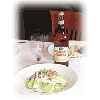Brouwerij De Landtsheer - Brussels Triple
-
ABV:
8% -
Int’l Bittering Units (IBUs):
24-26
This beer is called Brussels Triple, and I suppose that everyone knows that Brussels is the capital of Belgium, and the nearest thing that we have to a federal capital, like a Washington DC in Europe. Brussels is a bilingual city, they speak French, Flemish, German, and English, among others. I first encountered this beer at a little brewpub on the main square of Brussels, called the Grand Place or the Grote Markt. It's possibly one of the most beautiful squares in the world with lovely 17th century buildings, gilded decoration and lots of gables. And in fairly recent years they started the Grand Place brewpub.
What does triple mean? Is it triple strength? Well, sort of. If you see a beer in Belgium called a triple, it will usually be 8 to 9% alcohol, that sort of strength which is at least twice the strength of everyday beer. It's particularly associated with medieval and monastery brewing.
There is one brewery that is famous for its triple, and it is a Trappist monastery brewery called Westmalle, quite near Antwerp, which is the second city of Belgium. It was Westmalle that was the first to make a golden triple beer as opposed to the traditional dark. It was a golden colored beer with a very fragrant hop character, quite dry and fragrant, using Czech hops - the very expensive and famous Saaz.
Today we tend to think of "normal" beer as being golden in color. But in the history of brewing, beer was either cloudy or dark, and it was dark because
maltsters had not figured out how to dry the malt without exposing it to fire. It was only when they learned to have warm air dry the malt that it was
possible to have a golden beer. Golden beer is not better than dark beer, you just get a different taste. The world's first truly bright golden beer was
made in 1842 in Pilsen, the Bohemian town in the Austrian empire.
You know, I was terrible at geography in school, but since I started drinking beer my geography has improved enormously.
It took quite a while for golden beer to spread throughout Europe, when the railways started to grow. Eventually after the Second World War, a lot of pilsner beer was being made in Belgium. Brewers making the more traditional darker beers began to wonder what to do, and the monastery of Westmalle decided to make a blonde triple. With the blondness of the beer you tend to lose the roasty, toasty flavors of the dark malt, and get cleaner, perhaps less complex flavor. But they added complexity by using wonderful Saaz hops. It was very successful, and brewers all over Belgium started to make triples that were specifically modeled after Westmalle Triple. As time has gone on, it has become a major style, and different triples have developed their own identities.
This is a fairly new beer, and I am just getting to know about it myself. It takes a while to get to know a beer, like a new boyfriend or girlfriend, and there's a lot of fun in that phase. It's got a fragrant, chamomile hop aroma that you get from the Saaz hops. Crisp on the tongue, and light. High in alcohol at 8%, but quite light in body. Not light in flavor, it's got a long, lingering, developing flavor. A bit of vanilla, developing into quite a lot, though there is no vanilla added - it is just a flavor that develops in fermentation. A lot of fruity, spicy flavors develop in the fermentation of any beer, but particularly those made with ale yeasts. Quite dry on the finish, with a nice bitterness, which would make it a good aperitif. Bitterness arouses the gastric juices, which is why the Italians - who certainly know quite a thing or two about food - like to drink bitter drinks, like Campari, before a meal. This type of beer is very nice as an aperitif, but also with things like asparagus, or palm hearts, or crudités of some sort or another.
I'll always remember being in the Westmalle abbey one day, talking to the monk who ran the brewing part of the abbey. It was supposed to be a silent order, but he'd always bang the table with his hand when he made a point to me. And on that day he said to me "Mr. Jackson, (BANG), what wine could you possibly serve with asparagus?! (BANG)" And I thought, well this is a silent order, and you shouldn't really be banging the table. But he was also living a life of puzzling over great philosophical issues, like what wine to drink with asparagus. And he made it quite clear that I should be drinking his beer. I do think that triples in general go well with asparagus. Cheers.


Unmatched Variety by style, brewery & country
Choose from Five different Beer Clubs offering unmatched variety by brewery,
country of origin, and beer style to suit your specific tastes.


